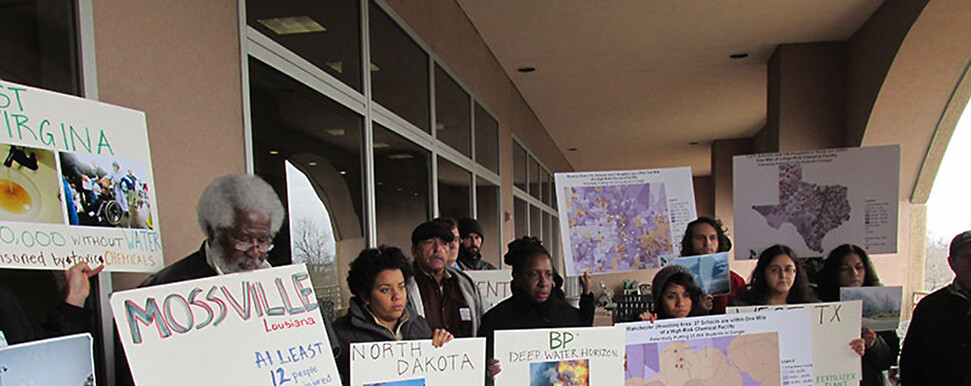
Media
April 20, 2022Health Experts and Healthcare Workers Call for Strong Chemical Safety Safeguards
Risk Management Plan Rule Needs Upgrade to Protect Communities from Pollution, Disasters
FOR IMMEDIATE RELEASE
by the Union of Concerned Scientists, Coming Clean, the Environmental Justice Health Alliance for Chemical Policy Reform, and Alliance of Nurses for Healthy Environments
Media Contact: Seth D. Michaels, 202-331-5662, smichaels@ucsusa.org
The U.S. Environmental Protection Agency (EPA) is updating the Risk Management Plan (RMP) Rule, a policy meant to protect community members who live and work near high-risk chemical facilities. In a new letter, hundreds of health professionals are calling on EPA to set the strongest possible standards, demanding reforms that bring chemical-safety rules in line with the demands of both science and justice.
While more than 200 million people in the U.S. live, work, or attend school near an RMP-covered facility, the threat these facilities pose is more severe for low-income households and communities of color, who are more likely to live near the fence line of one or more hazardous facilities. These communities are more likely to be impacted by a chemical-facility disaster like the recent explosion in Winston-Salem, North Carolina, that forced more than 6,000 people to evacuate their homes, or the recent chlorine leak in Plaquemine, Louisiana.
“Stronger chemical safety rules are long overdue,” said Sarah Bucic, a registered nurse and one of the signers of the letter. “The healthcare system has been under-resourced and severely strained by the COVID-19 crisis. Healthcare providers and the communities they serve are overburdened, and a severe chemical disaster could push them to the breaking point. Healthcare professionals can’t afford to wait for disasters to happen before EPA addresses the risk these facilities pose.”
Health experts note that it’s better to prevent chemical disasters in the first place than to try to manage the impacts after they occur. An effective chemical safety rule doesn’t just mean cleaning up in the aftermath of a disaster—it means truly reducing the risk that a disaster happens at all, and arming communities with the information they need to understand exactly what’s happening in their backyard. More than 300 experts and health professionals signed on to the new letter, which was delivered to EPA Administrator Michael Regan today.
"Fence line communities have been working tirelessly for chemical disaster prevention for decades. This call grew even more urgent over the past two years as these same communities of color and low-income people have been hardest hit by COVID-19." said Michele Roberts, National Co-Coordinator of the Environmental Justice Health Alliance (EJHA). "Workers inside RMP facilities and families living nearby shouldn't live at constant risk of preventable explosions, toxic releases and fires. Safer technologies and processes exist, but we need EPA to have the moral and political courage to require them."
In their letter, health experts offer several ways for EPA to strengthen the RMP rule as a tool to protect communities. They say that the RMP program should cover more facilities, push facility operators to adopt safer chemicals and processes, and require the disclosure of more information about what’s happening at the facility and what the impacts could be, including information available in multiple locally spoken languages. They also say that these rules need to consider the cumulative impacts of exposure to multiple facilities, the input of environmental justice and worker voices, and the dangers of climate change.
The health threat posed by chemical facilities is increasing, as multiple recent studies have shown that climate change poses a growing risk to these sites. A 2020 Union of Concerned Scientists (UCS) analysis and a recent report from the U.S. General Accounting Office (GAO) each indicate that around a third of hazardous chemical sites are vulnerable to the impacts of climate change, including sea level rise, extreme weather, wildfires, and flooding.
“The longer we delay, the more the danger compounds for the people who live and work near hazardous chemical sites,” said Jacob Carter, research director of the Center for Science and Democracy at UCS. “This is a potential public health emergency, and one that will likely hit hardest on the communities that already face challenges of pollution, inadequate healthcare access, and systemic racism.”
The proposed RMP rule is slated to be released for public comment by September 2022, with a final rule set to be issued by August 2023.
###
The Union of Concerned Scientists puts rigorous, independent science to work to solve our planet’s most pressing problems. Joining with people across the country, we combine technical analysis and effective advocacy to create innovative, practical solutions for a healthy, safe and sustainable future. For more information, go to www.ucsusa.org.
Coming Clean is a collaborative network of frontline community activists, environmental justice organizations, and policy, science and market experts, committed to transforming the chemical industry so that it is no longer a source of harm. For more information, please visit Comingcleaninc.org
The Environmental Justice Health Alliance for Chemical Policy Reform is a national network of grassroots Environmental and Economic Justice organizations and advocates in communities that are disproportionately impacted by toxic chemicals from legacy contamination, ongoing exposure to polluting facilities and health-harming chemicals in household products. For more information, see https://ej4all.org/.
The Alliance of Nurses for Healthy Environments is the only national nursing organization focused solely on the intersection of health and the environment. The mission of the Alliance is to promote healthy people and healthy environments by educating and leading the nursing profession, advancing research, incorporating evidence-based practice, and influencing policy.
http://enviRN.org
